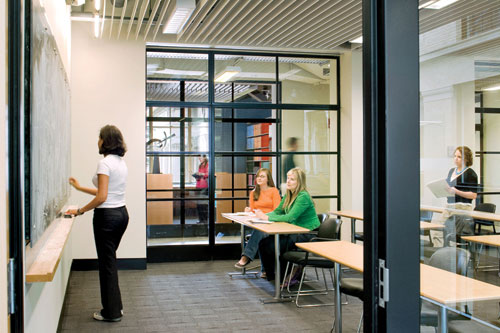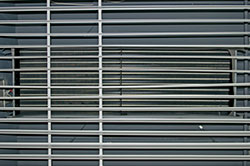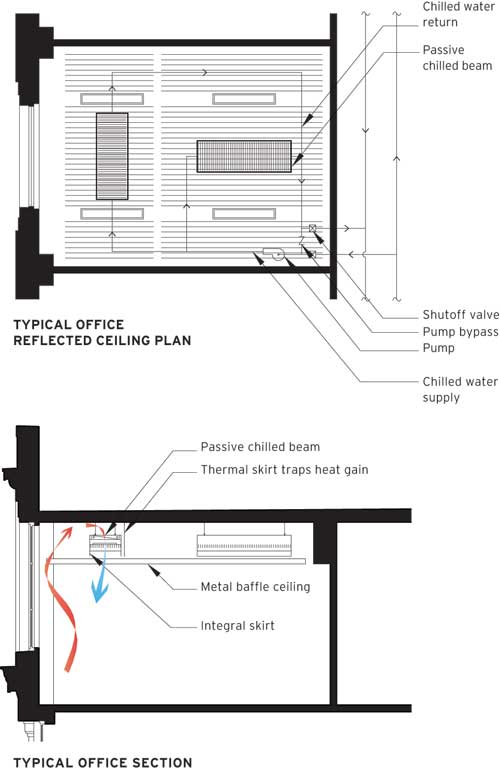An Energy-Conserving Technology From Europe Makes Inroads in the U.S.
To avoid condensation and prevent mold growth, it's important that the temperature of the water delivered to passive chilled beams be at least 2 degrees above the room's dew point, typically between 57 and 60 degrees Fahrenheit. Because this is warmer than conventionally chilled water, a building's central chillers can be smaller and less expensive. Some buildings draw groundwater to supply the beams, and require little, if any, additional water chilling. Chilled beams can be used in very hot, humid climates as long as interior humidity is controlled. This can be accomplished by dehumidifying the ventilation air, although this would then limit the occupants' freedom to open windows for natural ventilation. If the humidity of outdoor air is not a problem, passive chilled beams are compatible with natural ventilation.
There is an art to positioning passive chilled beams to maximize performance and enhance occupant comfort, according to Carl C. Schultz, director of advanced building technologies with URS Corporation, in Columbus, Ohio. They can be placed parallel and adjacent to exterior perimeter walls to counteract the effects of solar gain, he says. "The rising warm air near windows that will naturally come in contact with the cooling element will increase the beam's effectiveness as a heat exchanger," says Schultz. He recommends that passive beams not be placed directly above workstations since the velocity is highest directly below the units. He adds that placing them directly above a heat generator, like a copy machine, reduces the capacity of the beams because the rising warm air counteracts the flow of cool air dropping from the beam. More of Schultz's insights can be found in "Next-Generation Cooling Is Looking Up," in the May 2, 2007, issue of Engineered Systems magazine.
One major hurdle for this technology in the U.S. is the initial cost of the units. Even though they are relatively simple devices, they are expensive because, until recently, they had to be imported, according to Haiges. "When we first investigated chilled beams, contractors weren't sure what they were or how to install them, so they charged a premium," he recalls. "Now that cost is coming down.
 |
|
At MIT's PDSI (above), designers took a Images © Robert Benson (top); courtesy Payette (right) |
 |
Â
Haiges's firm worked with architects from Boston-based Payette to choose passive chilled beams for the low-occupancy spaces in the PDSI (Physics, Department of Material Sciences Engineering, Spectroscopy, and Infrastructure) Project at MIT, in Cambridge, Massachusetts (see page 172). Payette designed 50,000 square feet of new construction in a courtyard between three existing buildings, and renovated another 75,000 square feet to provide direct circulation links between the collaborating departments as well as additional programmatic spaces.
 |
Though visually porous, the baffles mask the view of the return-and- supply piping. The "plenum" below the building structure provides ample space for natural convection to occur. Images courtesy Payette |
Â
Rather than conceal the chilled beams with a metal casing or suspended ceiling, the architects took a "no-frills" approach and placed under them a visually porous ceiling of 4-inch high aluminum baffles, 4 inches on center. The "plenum" above gives ample space for natural convection, and the baffles mask the view of the supply-and-return piping. And despite a high first-cost for the beams, the project achieved net savings. "The chilled beams have few moving parts and no associated fan energy, eliminating a lot of ductwork, which meant cost and energy savings," explains Charles Klee, a Payette principal. "And we were able to go to a dedicated outdoor air system where the only air we're moving through the building is what's needed for fresh air, resulting in dramatic energy savings."









